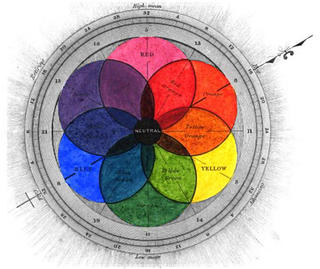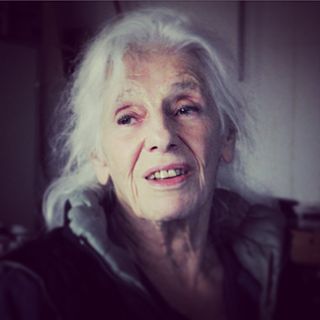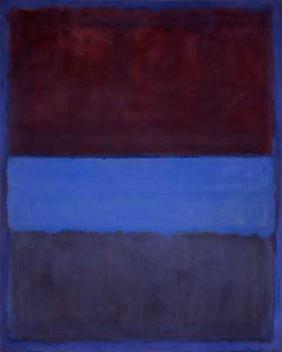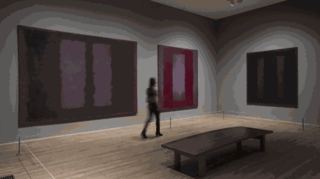
A set of primary colors or primary colours consists of colorants or colored lights that can be mixed in varying amounts to produce a gamut of colors. This is the essential method used to create the perception of a broad range of colors in, e.g., electronic displays, color printing, and paintings. Perceptions associated with a given combination of primary colors can be predicted by an appropriate mixing model that reflects the physics of how light interacts with physical media, and ultimately the retina. The most common color mixing models are the additive primary colors and the subtractive primary colors. Red, yellow and blue are also commonly taught as primary colours, despite some criticism due to its lack of scientific basis.

Mark Rothko, was an American abstract painter. He is best known for his color field paintings that depicted irregular and painterly rectangular regions of color, which he produced from 1949 to 1970. Although Rothko did not personally subscribe to any one school, he is associated with the American abstract expressionism movement of modern art.
Abstract expressionism in the United States emerged as a distinct art movement in the immediate aftermath of World War II and gained mainstream acceptance in the 1950s, a shift from the American social realism of the 1930s influenced by the Great Depression and Mexican muralists. The term was first applied to American art in 1946 by the art critic Robert Coates. Key figures in the New York School, which was the center of this movement, included such artists as Arshile Gorky, Jackson Pollock, Franz Kline, Mark Rothko, Norman Lewis, Willem de Kooning, Adolph Gottlieb, Clyfford Still, Robert Motherwell and Theodoros Stamos among others.

Clyfford Still was an American painter, and one of the leading figures in the first generation of Abstract Expressionists, who developed a new, powerful approach to painting in the years immediately following World War II. Still has been credited with laying the groundwork for the movement, as his shift from representational to abstract painting occurred between 1938 and 1942, earlier than his colleagues like Jackson Pollock and Mark Rothko, who continued to paint in figurative-surrealist styles well into the 1940s.

Op art, short for optical art, is a style of visual art that uses optical illusions.

Barnett Newman was an American artist. He has been critically regarded as one of the major figures of abstract expressionism, and one of the foremost color field painters. His paintings explore the sense of place that viewers experience with art and incorporate the simplest forms to emphasize this feeling.

Complementary colors are pairs of colors which, when combined or mixed, cancel each other out by producing a grayscale color like white or black. When placed next to each other, they create the strongest contrast for those two colors. Complementary colors may also be called "opposite colors".

The Rothko Chapel is a non-denominational chapel in Houston, Texas, founded by John and Dominique de Menil. The interior serves not only as a chapel, but also as a major work of modern art: on its walls are fourteen paintings by Mark Rothko in varying hues of black. The shape of the building—an octagon inscribed in a Greek cross—and the design of the chapel were largely influenced by the artist. The chapel sits two miles southwest of downtown in the Montrose neighborhood, situated between the building housing the Menil Collection and the Chapel of Saint Basil on the campus of the University of Saint Thomas. About 110,000 people visit the chapel each year.

Morris Louis Bernstein, known professionally as Morris Louis, was an American painter. During the 1950s he became one of the earliest exponents of Color Field painting. While living in Washington, D.C., Louis, along with Kenneth Noland and other Washington painters, formed an art movement that is known today as the Washington Color School.

Color field painting is a style of abstract painting that emerged in New York City during the 1940s and 1950s. It was inspired by European modernism and closely related to abstract expressionism, while many of its notable early proponents were among the pioneering abstract expressionists. Color field is characterized primarily by large fields of flat, solid color spread across or stained into the canvas creating areas of unbroken surface and a flat picture plane. The movement places less emphasis on gesture, brushstrokes and action in favor of an overall consistency of form and process. In color field painting "color is freed from objective context and becomes the subject in itself."

RYB is a subtractive color model used in art and applied design in which red, yellow, and blue pigments are considered primary colors. Under traditional color theory, this set of primary colors was advocated by Moses Harris, Michel Eugène Chevreul, Johannes Itten and Josef Albers, and applied by countless artists and designers. The RYB color model underpinned the color curriculum of the Bauhaus, Ulm School of Design and numerous art and design schools that were influenced by the Bauhaus, including the IIT Institute of Design, Black Mountain College, Design Department Yale University, the Shillito Design School, Sydney, and Parsons School of Design, New York.

Theodoros Stamos was a Greek-American painter. He is one of the youngest painters of the original group of abstract expressionist painters, which included Jackson Pollock, Willem de Kooning and Mark Rothko. His later years were negatively affected by his involvement with the Rothko case.

Josephine Gail Baer is an American painter associated with minimalist art. She began exhibiting her work at the Fischbach Gallery, New York, and other venues for contemporary art in the mid-1960s. In the mid-1970s, she turned away from non-objective painting. Since then, Baer has fused images, symbols, words, and phrases in a non-narrative manner, a mode of expression she once termed "radical figuration." She lives and works in Amsterdam, Netherlands.

No. 61 is a 1953 painting by the Russian-American Abstract expressionist artist Mark Rothko. The work was first exhibited at the Museum of Modern Art, New York in 1961 but is now in the collection of the Museum of Contemporary Art, Los Angeles. Similar to Rothko's other works from this period, No. 61 consists of large expanses of color with dark shades. Rust and Blue was a part of the Color Field movement. Rust and Blue also uses layered coloring. Rothko described this as "inner light". Rothko painted in such a way that at times paint can be seen flowing upward across the surface.

Katherine Bradford, née Houston, is an American artist based in New York City, known for figurative paintings, particularly of swimmers, that critics describe as simultaneously representational, abstract and metaphorical. She began her art career relatively late and has received her widest recognition in her seventies. Critic John Yau characterizes her work as independent of canon or genre dictates, open-ended in terms of process, and quirky in its humor and interior logic.

Orange, Red, Yellow is a 1961 Color Field painting by Mark Rothko. On May 8, 2012, it was sold at Christie's from the estate of David Pincus for $86,882,500, a record nominal price for post-war contemporary art at public auction.

Mark Rothko Art Centre is a multi-functional institution of culture, arts and education, located inside the arsenal building of the Daugavpils fortress in Daugavpils, Latvia. It is a unique in Eastern Europe, in that some original paintings of Mark Rothko are on public display, on loan from the proprietors. He was one of the greatest artists of the 20th century and was categorized by others, but not by himself, as a member of the abstract expressionism movement, specifically color-field painting, for his famous serene few color rectangle large paintings.

Orange Prince(1984) is a painting by American artist Andy Warhol of Prince, the American singer, songwriter, record producer, multi-instrumentalist, actor, and director. The painting is one of twelve silkscreen portraits on canvas of Prince created by Warhol in 1984, based on an original photograph provided to Warhol by Vanity Fair. The photograph was taken by Lynn Goldsmith. These paintings and four additional works on paper are collectively known as the Prince Series. Each painting is unique and can be distinguished by colour.

The Seagram Murals are a series of large-scale paintings by abstract expressionist artist Mark Rothko.

Ruth Pastine is an American artist known for abstract minimalist paintings that explore the phenomenological experience of color, light and space. Critics relate her art to the Southern California Light and Space movement, while identifying key differences, such as its focus on metaphysical aspects of consciousness and its reliance on basic, traditional means rather than synthetic-industrial materials. In these regards, writers trace her artistic lineage to Monet and Malevich—who sought to capture light's ineffability—and to Abstract Expressionist and Color field painters such as Barnett Newman, Ad Reinhardt and Mark Rothko, who probed the chromatic and tonal nuances of oil paint. Pastine's paintings typically consist of seamless gradating bands or fields of color built in layers with countless brushstrokes, which optically coalesce and appear to pulse, float, dissolve, or glow as if backlit. Peter Frank has written that she "paints as purely optical a kind of painting as it is possible to paint … nothing but color and its presentation, with myriad, closely shifted color modulations."



















